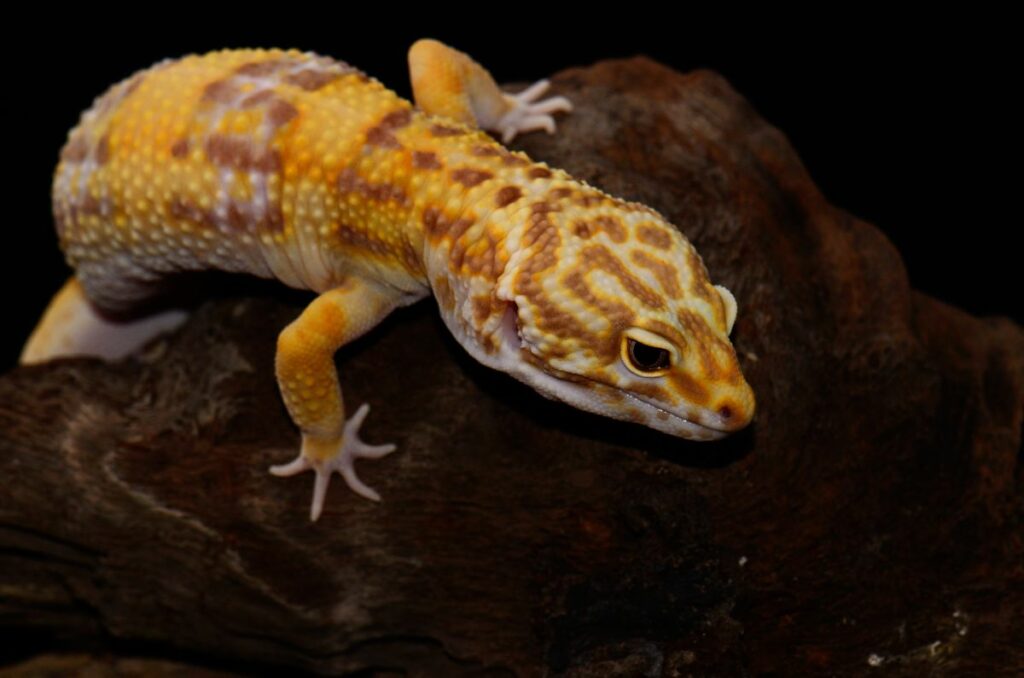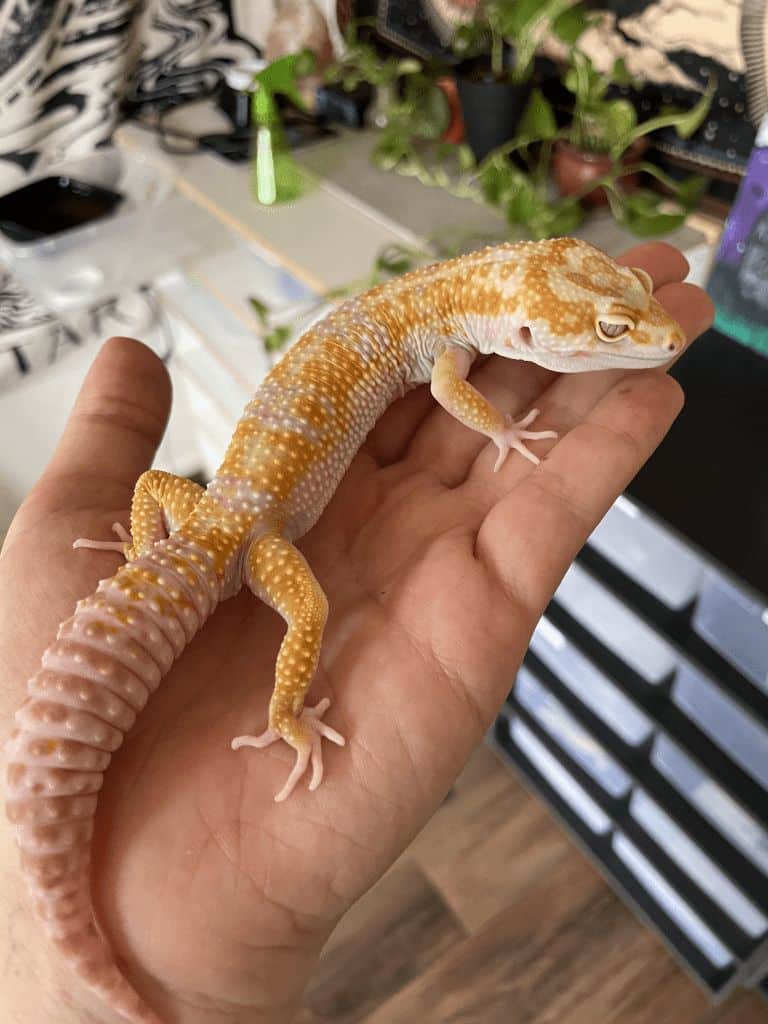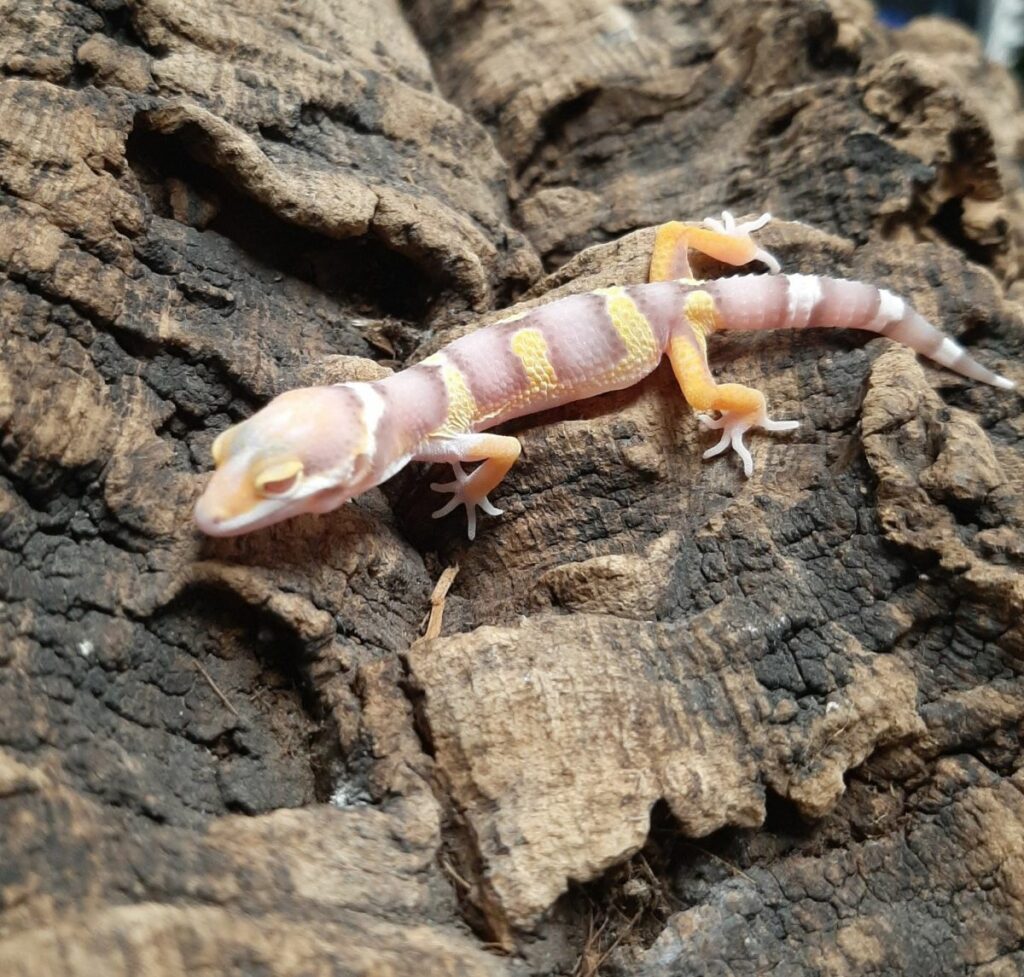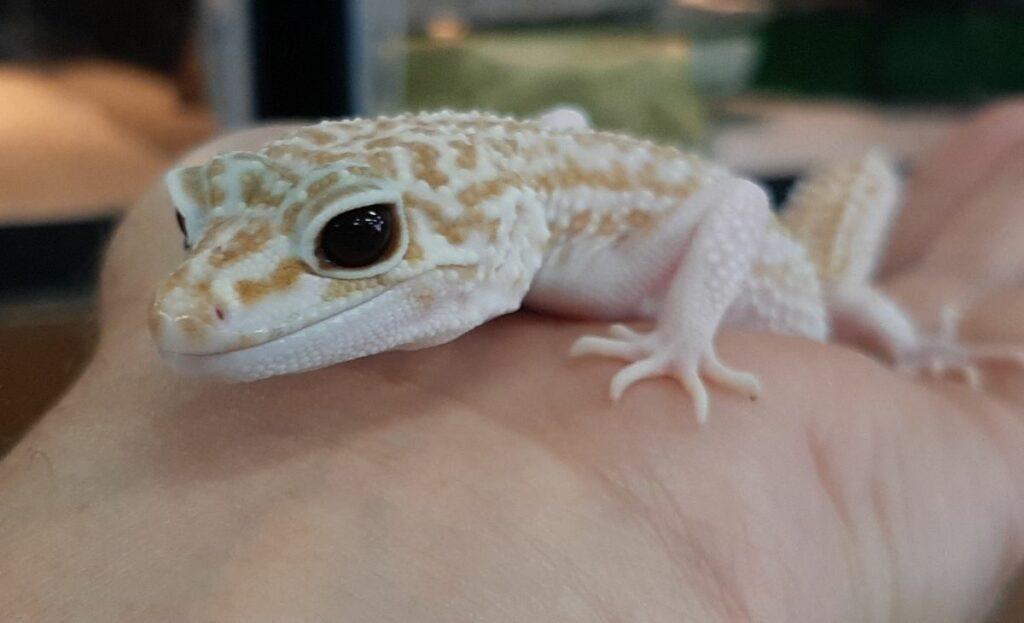I always recommend albino leopard geckos to hobbyists that want a lizard that will thrive in a small tank. Yet still enjoys being handled and is easy to care for. The normal leopard gecko color morph is attractive enough. But the albino variety adds an exotic touch to these otherwise common pet reptiles.

What is the Albino Leopard Gecko?
Albino leopard geckos are members of the gecko subfamily Eublepharidae. These lizards share several of the same traits of tree-dwelling species.
Except as ground-dwelling lizards, Eublepharid geckos have no need for the clinging toe-pads that allow other species to climb sheer walls and glass.
Albino leopard geckos and their relatives also have the ability to blink. Other geckos have a hard membrane protecting their eye, which they clear dust from by licking.
Leopard geckos still have a long tongue, though. They use it to taste and explore their surroundings, including your hands when held.
Almost all animals may be bred for albinism, where a creature is not able to produce the pigment melanin. Melanin is a dark brown pigment found in our eyes and skin.
Its loss in the eyes is why they look blood red in true albino animals. Albinos still have other skin, feather, and scale pigments, however.
Rare Leopard Gecko Morphs
Finding an albino leopard gecko is a little more difficult than a standard color morph. They cost anywhere from $200 to $800, depending on the genetics and size of the lizard.
They are not the rarest leopard gecko, though. Those would be black knight leopard geckos, a hypermelanistic variety that cost $900 to $1900 per lizard.
One rare leopard gecko is the Florida or Bell albino leopard gecko. These are named after the breeder Mark Bell, who discovered and fixed this bloodline. They have a very delicate lavender tint to their bodies and fainter skin patterning with brown spots.
Tim Rainwater developed the rainwater leopard gecko in 1998. His variety is the smallest of the three main albino leopard gecko varieties. They have the most pink skin color and the darkest eyes. Baby rainwater leopard geckos are bright yellow with pink banding.
Tremper albino leopard geckos are another common variety and vary more in appearance. They range from light brown to yellow. Their irises are silver, making them easy to distinguish from the other two varieties.
Another is the chocolate albino leopard gecko. They are true albinos as well; just one that’s been incubated at a lower temperature. Resulting in a lizard with darker skin patterning.
Leucistic leopard geckos are often mistaken for true albino leopard geckos. A leucistic animal is one that has no genes for any pigmentation. Since they aren’t true albinos, they are less expensive, costing around $50.
You can quickly tell the difference between an albino and a leucistic animal by checking its eyes. Leucistic animals still have black or brown eyes, unlike an albino creature. Leucism is also partial at times, as in a piebald ball python.
- Common Name: Albino Leopard Gecko
- Scientific Name: Eublepharis macularius
- Origin: South Asia
- Length: 8 to 10 inches
- Tank Size: 20 gallons
- Albino Leopard Gecko Lifespan: 15 to 20 years
- Ease of Care: Very Easy
Caring for an Albino Leopard Gecko
Albino leopard geckos are excellent pet lizards for beginners. They eat insects and their setup requirements are inexpensive and easy to source

How Big Do Albino Leopard Geckos Get?
An albino leopard gecko full grown is about 8 to 10 inches long, much like the normal color variety. A single adult will be comfortable in a 20 gallon aquarium.
Go with the long variety over the high style as it has more floor space. These are ground-dwellers and don’t need any vertical space for climbing.
If you want to keep two albino geckos together, they will be comfortable together in the same size tank. But add 5 to 10 gallons of volume per additional gecko.
Female white leopard geckos will coexist, as will one male with one or more females. But two males should never be kept together as they are territorial animals and will fight.
Decorations and Substrate for a White Leopard Gecko
Albino leopard geckos prefer a sand substrate. Regular pool or aquarium sand is fine but I prefer reptile calcium sand. Especially with this species of lizard.
When an albino leopard gecko eats, it tends to lunge with its mouth wide open. The lizard gets a big mouthful of sand, which it swallows with its prey. If it eats enough sand, the grit may cause intestinal blockages that are fatal.
Calcium sand is not just clean and attractive. It’s also digestible so the lizard won’t get blocked up.
Other decoration items include hides, low branches, and rocks. Use multiple hides if keeping more than one lizard to avoid fights over choice hiding spots.
What Kind of Lights Do Leopard Geckos Need?
Leopard geckos are desert dwellers but they are also nocturnal. So they need moderate temperatures compared to uromastyx and other day dwelling desert lizards.
Temperatures during the day should reach 90-95℉, with a cooler zone of 75℉. At night, the enclosure temperature should fall to 70-75℉.
An infrared basking light should be the main heat source during the day. Once the lights go out, a heating pad or heat tape paired with a digital thermometer will keep the tank warm enough.
Do Leopard Geckos Need UVb?
Leopard geckos are active at night so they don’t need a UVb light. They do benefit from some UVb light as it helps them create small amounts of vitamin D3 for calcium synthesis. In the wild, the albino lizard gets some UVb as the sun starts to set. But once night falls there is no UVb available.
Food enriched with vitamin D3 powder will give an albino leopard gecko the small amount they need. But there’s no harm in letting a UVb light run for a few hours each day as an added boost.
Albino Leopard Gecko Humidity

Maintaining a proper humidity level is important for an albino leopard gecko. That said, it’s not difficult to do since they thrive in the same range as most people’s homes. 20-40% keeps them dry enough to avoid infections. Yet leaves enough moisture for successful shedding.
If your home tends to be drier mist the enclosure once per day. A hygrometer attached to the glass will tell you when it’s time to mist again.
Albino leopard geckos are desert animals but some moisture is needed. Dry sheds lead to major problems, including toes being amputated when skin cuts off circulation.
Also give your geckos a small water bowl to drink from as they do drink standing water. A water bowl will also help maintain moderate humidity. The bowl does not need to be large enough to soak in. And it should be shallow so the lizard can climb out with ease.
What Do Leopard Gecko Albino Eat?
Albino gecko leopards are insectivorous lizards. They feed on small invertebrates like insects, arachnids, and worms. Feeder insects are plentiful at pet stores and they are also very easy to raise yourself.
Good feeder insects for the foundation of an albino leopard gecko’s diet include crickets, dubia roaches, and mealworms. Supplement basic insects with the occasional fatty treat.
Richer bugs include wax worms, hornworms, and silkworms. But don’t feed them too often as obesity is an issue with captive lizards. Vitamin dust and gut-load any insects you buy before feeding as well, to boost their nutritional content.
An albino leopard gecko full grown may also eat pinkie mice. But these should be offered as an occasional treat. Their digestive system is optimized for insect prey.
Feed your gecko every other day as an adult. A baby albino leopard gecko should eat every day.
Handling an Albino Leopard Gecko

An albino white leopard gecko is one of the most handleable lizards you could ask for. They are very tame; in fact leopard geckos were the first lizards to be domesticated.
Leopard geckos almost never bite and are even trustworthy enough for children to hold. Rough handling may cause them to defend themselves, like squeezing or dropping one.
Otherwise they are calm reptiles and enjoy the warmth of human hands. They aren’t stressed by even regular handling. When allowed to walk around they explore with care and won’t dash away like a green anole or tokay gecko will.
They don’t have adhesive toes and can’t stick to you as well as a crested gecko, though. So make sure the lizard is well supported at all times.
Also make sure you are careful with their tails. Albino leopard geckos will drop them as a defense against predators if grasped. Like most lizards, the tail does grow back. But it often grows back stunted and discolored.
Leopard geckos also use their tails to store fat, giving it a plump look. Much like their close relative the African fat-tailed gecko.
Losing their tails lets them live for another day. But it’s also a major loss of stored nutrients and a shock to the system of the lizard.
Conclusion
The albino leopard gecko is a beautiful variety of an already amazing lizard. They are ideal first lizards, even for children. Given warmth and plenty of nutritious insects they will live for decades.
FAQs
The albino leopard gecko is rarer than the standard variety. But there are several morphs that are even less common, including the black knight leopard gecko.
Some do have vision problems and a few are born blind. But full blindness is rare and a lizard found for sale is not likely to be blind. Total loss of vision makes feeding impossible. An albino leopard gecko with vision trouble may need to be fed by hand using feeding tongs.
Other than the possibility of vision trouble, no. Albino leopard geckos have the exact same care requirements as any other rare leopard gecko morphs.
